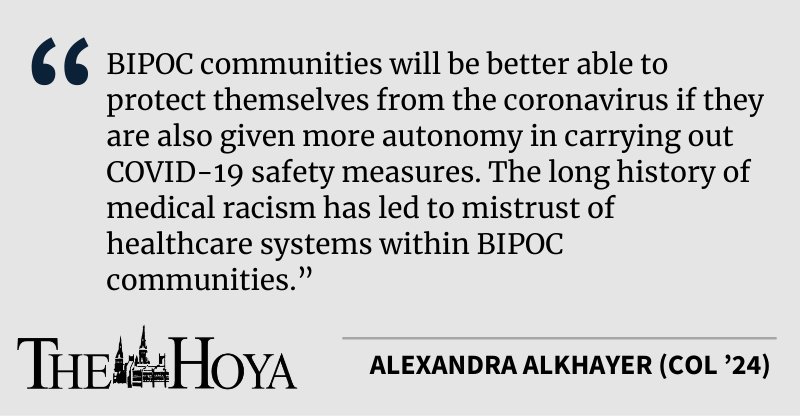As the general public begins to brace itself for the second wave of coronavirus, health experts warn we are already in its midst.
In the United States, the number of cases reported in a single day continues to reach new highs and, once again, calls attention to the disproportionate impact of the virus on communities of color: The rate at which Black people are dying from COVID-19 is 2.1 times higher than the death rate for white people. Systemic racism in the United States largely accounts for racial health disparities in COVID-19 cases, and the implementation of short-term policies that improve access to health services is necessary to begin overcoming the longstanding discrimination in healthcare.
Because of inequities that impede many Black, Indigenous, and People of Color from obtaining essential resources, BIPOC face a higher rate of chronic illnesses like diabetes and cancer. These underlying health conditions have already put BIPOC at an increased risk for severe illness from COVID-19.
To make matters worse, many economic barriers have prevented BIPOC from accessing treatment. Institutional racism has put BIPOC at an inherent disadvantage concerning credit unions, loan associations and insurance companies. BIPOC are less likely to be insured and more likely to have lower socioeconomic status than non-Hispanic whites, which makes attaining treatment for general health conditions and COVID-19 extremely difficult.
Considering how nearly 50% of Americans have employer-provided health insurance and the U.S. unemployment rate rose from 3.5% in February to 14.7% in April, millions of Americans have lost their health insurance during the COVID-19 pandemic. Although the unemployment rate declined to 6.9% in October, BIPOC have not recovered as much as white people; half of white Americans have regained employment, while only one third of Black Americans have had the opportunity to do so.
These disproportionate unemployment rates reflect another important trend: Many occupations that put workers at higher risk of contracting coronavirus, like jobs in public transit and grocery stores, are filled by BIPOC. This disparity is because of the inaccessibility of higher education for BIPOC communities, which prevents them from getting higher-paying and lower-risk jobs.
To begin to combat these ingrained inequities, COVID-19 resources must be made more accessible to BIPOC. Federal and state governments should provide sufficient funding for local public health services that cater to communities of color; this funding will play a large role in establishing preemptive safety measures to respond to COVID-19 outbreaks.
Improved funding will make personal protective equipment obtainable by all community members, which will decrease the risk of illness. Funding will also increase testing capacity and allow for the implementation of testing in convenient locations like places of worship. This widespread, accessible testing will enable communities to protect themselves from COVID-19.
BIPOC communities will be better able to protect themselves from the virus if they are also given more autonomy in carrying out COVID-19 safety measures. The long history of medical racism has led to mistrust of healthcare systems within BIPOC communities.
Time and time again, medical institutions have failed BIPOC in providing compassionate, effective and ethical care. Many medical experiments have involved Black people who never gave their consent. In 1932, the U.S. Public Health Service assured 600 Black men who either had or did not have syphilis that they would receive free treatment for various illnesses, but researchers did not provide the men with any healthcare. Up until 1972, researchers merely observed the men, thus betraying the original deal with the patients.
Numerous other instances of medical racism exist, and BIPOC must be given the opportunity to become more involved in enforcing COVID-19 measures like testing and contact tracing within their own communities in order to promote effective representation. Members who can help administer tests and conduct contract tracing will both assist their community in preventing the spread of COVID-19 and foster trust in healthcare systems. At the same time, trusted members will more effectively provide support and resources because they will be better informed about their community’s needs.
With the federal government hoping to release the first supply of a COVID-19 vaccine by the end of 2020, a new priority emerges: making the vaccine accessible to communities of color.
Despite the fact that BIPOC have experienced greater rates of coronavirus infection and hospitalization than white people, the history of racial inequity in healthcare suggests the communities at the greatest risk will not receive treatment first. Equitable vaccine distribution is crucial to reduce COVID-19 morbidity and mortality rates in communities of color. Although short-term policies will not erase the centuries of oppression enforced by U.S. institutions, these policies can begin to unravel these racist systems.
Racial health disparities are not exclusive to the pandemic, and future steps in the accessibility of healthcare must work to prevent any further devastation of communities of color.
Alexandra Alkhayer is a freshman in the College.









